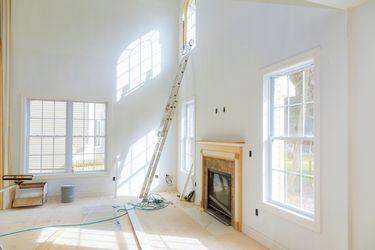
Written by Kayla Jane Barrie Updated on Mar 03, 2025 6 mins read

Home replacement cost is one of the most important factors to consider when you get home insurance. Having enough coverage will put your mind at rest knowing you’ll receive enough funds to rebuild your home after a sudden accident.
With property values rising across the country, it’s essential to think about replacement costs. The amount in your policy will significantly matter if your house is severely damaged or destroyed from a natural event such as flooding, or a fireplace accident.
Whether you are buying a new house or looking to understand the replacement cost of your current home, we explain how it works and how to easily use a cost calculator to determine how much of a limit you need.
Home replacement cost, or replacement value, is the amount of money it will cost to replace it from the ground up. It is used to calculate the cost of rebuilding your house if it's been devastated by fire, weather events, or other perils. When choosing what to add to your plan, consider where you live - if you're in an area prone to extreme weather, you'll want to have extra protection.
It's also important to consider if you are doing any home renovations, to let your insurer know. If there are any accidents or liabilities, you want to make sure your home value is updated. Renos can increase your replacement cost and monthly/yearly payments. An example of this would be if you were to add a swimming pool, which requires additional coverage.
Many policies break down your agreement into dwelling, detached structures (if applicable), and personal property.
Most policies require you to have at least 80% of your rebuilding cost included in your agreement. This amount could be increased or decreased, but always speak with your insurer to confirm what is covered. Set the amount at a number you are financially comfortable with.
Let's use an example to illustrate this point. Let’s say you have a $300,000 replacement cost. In this instance, the insured-to-value threshold is 80% of $300,000, or $240,000. This is your coverage limit. 80% is a standard number in most policies.
You have a house fire. Your total claim for repairing the damage is $50,000. With an 80% replacement value, your insurer would pay the full amount up to your coverage limit - $50,000 in this case.
But, if you have a replacement value lower than 80%, most insurers will only pay a percentage of the damage. It would be the same replacement cost value percentage. So, if you have 75% replacement value, they would cover 75% of the claims costs.
| Dwelling coverage | % of RCV* | Claim payout |
|---|---|---|
| $300,000 | 80% | $50,000 |
| $300,000 | 75% | $37,500 |
| $300,000 | 60% | $30,000 |
*replacement cost value
Guaranteed replacement cost provides additional protection above the replacement value. It will pay for the replacement of your home without depreciation factored in. Even if the damage is more serious than your value limit, your insurer will fully replace your property and possessions.
For example, your home is insured at a guaranteed replacement cost of $300,000. Your home is significantly damaged in a storm. After evaluating the damage, it will cost $350,000 to replace. If you have a guaranteed replacement cost, the additional $50,000 will be covered.
Paying a little more for guaranteed replacement costs gives you peace of mind in knowing your home will be repaired, even if the costs exceed your coverage limit.
This is important because as property values increase, it becomes more difficult to estimate the costs accurately. Home improvements around your property only make it more complex. You may also need to consider insurance endorsements to customize your needs.
Guaranteed replacement cost is commonly associated with the cost of the dwelling, and replacement value is commonly referred to when talking about personal property.
Replacement cost means damaged items and parts of your home will be repaired, if possible, or replaced with a new item of the same quality without depreciation. Guaranteed replacement cost means your home is covered for the full amount to replace your dwelling, even if it exceeds the replacement limits. Depending on where you live, you may also need higher or lower costs. If you live in the city, you may want to speak with a Toronto broker to confirm the costs associated with replacement.
Various factors can impact reimbursement and rebuilding costs for your home. Some include:
Calculating replacement costs is important to understand the true value. There are four main ways to calculate the value of your home if you need to replace it:
Here are five tips to calculate replacement costs and ensure you have adequate protection:
After you assess these considerations, speak to a ThinkInsure representative to update your policy.
Actual cash value (ACV) takes depreciation into account when calculating a home insurance claim. Replacement cost does not take depreciation into account. How much you are compensated can vary significantly based on which payout calculation is used.
For example, using actual cash value, the 3-year-old television you purchased for $1500 may only be valued at $500 today. Using replacement cost, your television would be replaced with a new TV with comparable features.
If you are unsure which method to use to calculate replacement costs, contact your insurer for more information. If you have ACV, you can increase your plan to include full protection.
Homeowners often mistake current market value and replacement costs - not what they can get on the real estate market. Market value also includes the land, while replacement cost does not. For example, you may be able to sell it for $500,000, but it may only cost $250,000 to rebuild. You are only covered for the cost of rebuilding.
Replacement coverage will cover the cost of restoring items or replacing them with items of the same quality as the ones lost. The better home insurance you have, the better you will be protected and reimbursed in the event of a claim. It's always worth considering additional options like overland water insurance or sewer backup insurance.
Most insurers will not allow you to move from your current dwelling. The purpose of this reimbursement is to rebuild and repair what you already have, not to relocate and buy a new home.
Yes, your replacement value, as well as the type of policy, will impact the cost of your monthly and annual payments. A lower replacement value and lower levels of protection will reduce your costs. But it could also leave you exposed. You may also not have access to full benefits to cover accommodations while your home is being repaired or rebuilt.
Replacement costs won’t go up and down with the real estate market, but they can change depending on the costs associated with labour and materials becoming more expensive. This is also why it’s important to have proper insurance during a renovation, as it could impact the cost to rebuild your home.
Home replacement costs should not be taken lightly or simply estimated. Take time to evaluate your home and belongings. Speak with the experts at ThinkInsure to answer any of your questions and to ensure your home insurance in Ontario meets your home value.
| Categories | Home |
|---|---|
| Tags | Protect Your HomeHomeowners ClaimsHome Coverage |
Read our insurance blog to get helpful tips, information and news.
Get the facts on Toronto's auto theft problem. We break down the data, reveal the most-stolen vehicles (including the Honda CR-V and Lexus RX 350), and show which neighbourhoods are most affected.
Dive into the world of auto theft with our blog on the most stolen cars in Canada. See the most stolen cars across Canada, including provincial lists for Ontario and Quebec, and learn how high-risk models can affect your car insurance premiums.
Drive safe this winter! Check out these tips for driving in snowy and icy conditions in Ontario. Get other helpful info and FAQs on winter driving.
Drive safer this winter. Learn how the right set of winter tires drastically reduces stopping distance and risk on ice and snow. Get expert tips from your trusted insurance provider.